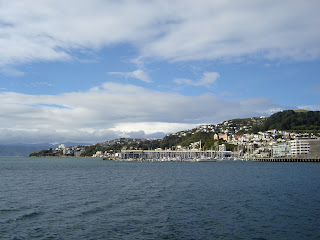
I'm on my way to quickly adjusting to life here in Wellington. The walk down this hill each morning
is beautiful and very much a job
for my Nikes as I carry my stilettos to work in my bag. I'm becoming more accustomed to life here. The pace of the city is so relaxed and generally without stress, a stark chan
ge from the hustle and bustle of Manhattan life. Nobody seems to be in much of a hurry, and the rhythm of the way of life is mellow. It's a refreshing change and definitely something I am grateful to have a chance to experience. New York is still in my heart though, of course.

At work at the Wellington Community Law Centre, I take on more responsibilities each day. Last week I began researching ways that our centre can be more receptive to the needs of the Maori community. New Zealand ("Aotearoa" meaning "the land of the long white cloud") is a bicultural society. While there are many more than just two cultures here today, from a historic perspective the original inhabitants of Aotearoa were the Maori, Polynesian occupants of the land since the estimated 10th -11th centuries. It was not until the early 19th century that European settlers came to Aotearoa, and so was born what is known as the Pākehā culture today. The term is used generally used to refer to those of European, non-Maori descent today. On 6 February 1840, the Treaty of Waitangi between the British Crown and a substantial number of Maori chiefs establishing rights for the Maori people in the eyes of the Crown and sacrificing some degree of Maori sovereignty or governance. There is still dispute as to what exactly the Treaty indicated because of mistranslation with the language barrier. The Crown believed that the Maori agreed to Crown sovereignty, but the Maori chiefs agreed only to Crown governance, maintaining a degree of autonomy over their own affairs. Within the judicial system today, there is a separate specialized court system for Maori land affairs. The Wellingon Town Hall pictured at left is a perfect example of the way that Maori culture is very much celebrated in New Zealand today. Most every sign/building is written in English along with Maori.
Community law centres exist regionally around New Zealand, but the centre, Te Ratonga Ture, that was dedicated to providing services for the Maori community by Maori lawyers and volunteers in Wellington had its funding cut. Because of this, there is a real void to fill in the interest of these legal needs. I am working to develop an education reference for our volunteer lawyers regarding Maori legal issues, particularly in land rights. Also, the reference will focus on ways that we can become more culturally sensitive to Maori clients' needs and preferences. This will be an ongoing project for me throughout my time here.

You can see some of the "long white clouds" that New Zealand is so named after in this picture that I took from the harbour in Wellington. Since I work not too far from the waterfront, I take a good number of walks around to take in the views. Even on a windy, rainy day which comes fairly frequently in the New Zealand winter, the sights really are breathtaking.
2 comments:
Beautiful photos! What a stunning environment in which to work... Happy to hear you are well!
Beautiful photos Kelly!
Post a Comment